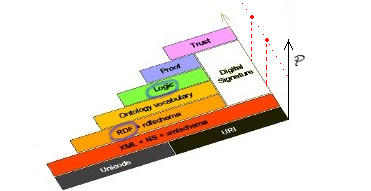|
Metalog
The goal of the Metalog's PNL ("Pseudo Natural Language") is to define a technology that is very close to the people, even if this possibly means sacrificing part of the expressive power of the underlying tower (in other words, to start filling up the upper parts of the P axis). The PNL, as the name says, aims to use a very colloquial form of communication, that is very close to humans: natural language.
For instance, the following is a piece of an example from the Metalog distribution:
JOHN and MARY OWN a "red house".
As we can see, the idea is to sit high enough in the P axis, so that people can understand what this is about, without the need for reading complex manuals and getting acquainted to the computers' terminology. It is then, for one time, up to the machine to do the effort of understanding this, and push it down to some place in the underlying tower.
In fact, Metalog has at its core a two-tier architecture: on the one side, the Metalog logic, and on the other side, the Metalog PNL. The Metalog logic sits in the "Logic" part of the tower, that is to say, in the expressiveness axis: it is a foundation technology, designed for the computers. On the other side of the spectrum, this level interacts with the PNL, which dually, sits above it in the P axis. Pictorially, we could represent the position of the PNL like

In its current version, the Metalog PNL has some important properties, that are useful to analyze in order to better understand its advantages and disadvantages.
First, note the "pseudo": the PNL is not a "Natural Language" interface. Pseudo here means that the natural language that is used here is not the whole natural language that we all use, but a subset of it (roughly, it corresponds to those very basic grammar rules we were taught in our first years at school). This means that the PNL sits middle-way in the P axis, not so high as to fully interact with humans without any compromise.
More precisely, the current PNL has been designed to be an "r-language", which means, it is very easy to read (and hence, to understand). In fact, if used properly, the PNL makes trivial for people to understand concepts and sentences in the Semantic Web.
On the other hand, if you are a developer or want to write information using the PNL, you can't just write everything: as said, the current PNL limits the language to a very simple form; this implies some amount of adaptation is still needed in the writing phase, although it is not that much (essentially, just forget all the involved grammar you learnt in high school and think you are a kid...).
This little price to pay has an important consequence: the PNL is an unambiguous language. In other words, there are no ambiguities in what you can write, as every sentence has a precise and determined meaning, not subject to interpretation and doubts. So, the current PNL sacrifices the total freedom of natural language, where ambiguities and interpretation problems exist, to give you a more restricted, but totally safe environment: a discourse written in the PNL has the same meaning for every computer.
While we have talked of the little price that humans have to pay to the PNL, we haven't talked about the price that computers have to pay. As we have said, staying high in the P axis can mean that part of the underlying expressive power is lost (in other words, that there is no "free meal" for both the two worlds, computers and humans). In the current Metalog PNL case, this means that not all of the Metalog logic is expressible using the PNL. In other words, there are some special concepts that computers can express in the Semantic Web world (in the Metalog logic), but that they cannot express using the PNL: in order to use them, you will have to abandon the PNL, and sink down the P axis. The important thing is that the current PNL has been designed so to minimize, as far as possible, this lack of expressiveness: the PNL favors common use, and so it should suffice for most normal uses.
[Back to: The Semantic Web Made Easy]